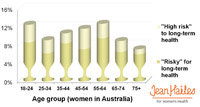Sexually Transmissible Infections Through The Ages

Sexually Transmissible Infections Through The Ages
For many of us, sex plays a vital role in our health and wellbeing. Research shows that older women are still interested in sex, however, Australia's increasing rates of sexually transmissible infections (STIs) in the over 65s suggests that practising safer sex might not be top of mind.
STIs are diseases or infections which can be passed on during close contact with an infected partner. You may think they only affect young people, but you can catch an STI at any stage of your life! Knowing about safer sex is important for you in your 60s as well as in your younger years.
Worldwide, rates of STIs amongst people in their 50s, 60s and 70s have almost doubled in the last decade. This may be due to people going back onto the dating scene in midlife and being unaware of the need to practise safe sex. There is a growing concern amongst sexual health educators that people in midlife are not getting the information they need. They are not the only ones though – a survey showed that 39% of sexually active students only used a condom 'sometimes" when they had sex. The advice for all sexually active people, no matter what their age is still the same, unless you and your partner have been given the all-clear, use a condom.
STIs can be caused by bacteria, viruses or parasites and you may not even know if you have been infected straight away. Some STIs you may or may not have heard about include: chlamydia, gonorrhoea, syphilis, trichomoniasis, HIV, genital herpes, hepatitis B and human papillomavirus (HPV). Candida (thrush) is another cause of vaginal infection, however, is not transmitted by sex.
You don't need to have penetrative sex to get an STI: oral, anal and in some cases skin to skin contact is often enough. As many STIs have no symptoms, potential partners can be totally unaware of the fact they have an infection. Most doctors recommend getting an STI check before starting a new sexual relationship. Many couples agree to use condoms until they have both been given the all clear.
Using a condom during sex not only protects you from pregnancy, it prevents bodily fluids being shared, which is how many STIs are passed on. Use a lubricant made for condoms, as some products could damage the condom, causing it to split. If you are allergic to latex, ask about using a female condom.
If you are engaging in oral sex you can protect yourself by using a latex dam. This is a small rectangular sheet of latex which can be placed over your genital area before contact. Both condoms and dams need to cover all areas of infected skin in order to protect you though.
Many older people may be embarrassed to discuss sex with their doctor or to seek advice about the risks they may face. Historically, safe sex campaigns have often targeted teenagers or young adults, so these messages are not reaching the older, sexually active population.
Women who have been through the menopause may suffer from vaginal dryness, which can cause discomfort when using condoms; leaving them at greater risk of STIs if they decide not to use them. There are a number of lubricants available that can help overcome vaginal dryness. Fear of erectile dysfunction in older men may also lead to less inclination to use condoms which put both parties at risk. If this is the case, a conversation and a sexual health check-up with your health professional can help.
If you are worried that you may have been infected, contact your GP or sexual health service to arrange a check-up.
A wide range of information about sexual health can be found on our website: https://jeanhailes.org.au/health-a-z/sex-sexual-health
Published with the permission of Jean Hailes for Women's Health
jeanhailes.org.au
1800 JEAN HAILES (532 642)
Have You Seen This?
MORE


















